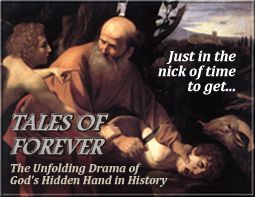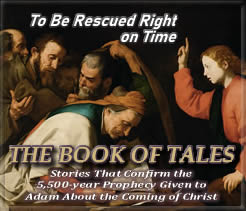The Stage is Set
Anchor of Faith
Before we proceed to The Tales presented in this volume, I would like to take one last opportunity to review the scenario that we have established so far. When comparing the canonical books of The Bible with those of the so-called “apocryphal” texts, it is abundantly clear that they are deserving of our attention and admiration. First and foremost, they are “worth their weight in gold,” as it were, because of the way in which they consistently corroborate the more enigmatic portions of the Canon. Some of the greatest mysteries that have haunted humanity throughout the ages are thrown into an entirely new light when one simply takes the time to consider the implications of the apocryphal record. How did Noah get all those animals into the Ark? Why did he pronounce such a devastating curse on his grandson, Canaan, just because Ham, his father, found him lying in his tent, naked and passed out? And why would Esau, who was described as a cunning, greedy man, so casually sell away a birthright that by all accounts would have brought him untold riches and power? The answer, if the apocryphal record is to be believed, lies in the mystical power of the sheepskin garment that God provided for Adam, which was unmistakably a type of the covering that would one day be provided by none other than the Lamb of God, Jesus, Who was slain before the foundations of the world were laid.
The apocryphal literature also demonstrated its supreme importance when it revealed its ability to provide a clearer picture in terms of God’s salvation of Adam by way of Abraham, Isaac, and Jacob. When God promised to rescue Adam and his descendants after The Great Five and a Half Days of prophetic time, He laid the groundwork for this rescue effort by utilizing Abraham and his son. Not only was Isaac a willing participant in volunteering himself as a burnt offering to the Lord, but as a type of God’s Son in every dimension he—quite unlike The Book of Genesis portrays him—was a grown man, completely aware of what his father was doing when he was led to Mount Moriah. Most importantly, as a result of their audacious act of obedience, Abraham and Isaac uniquely foreshadowed the way in which the ultimate salvation of mankind would someday be carried out on Calvary.
Finally, in verifying how a study of God’s usage of typology provides an anchor of faith, it was again demonstrated that the apocryphal record can be counted on. When biblical historians seek to exemplify God’s preponderance for using types in The Old Testament to foreshadow the life of Jesus, they consistently turn to Joseph—the dreamer so despised by his brothers. In the life of Joseph, it is said, one can find, more than anyone else in Scripture, a type of Christ Who was to come. The only problem is: There are so many elements in the life of Jesus that are missing from the canonical record of Joseph’s life that this prophetic correspondence between the two becomes very difficult—if not impossible—to accept. However, many of the important elements that are missing from the received texts can be found in the apocryphal literature when one simply takes the time to examine it.
Story Continues Below
To hear Kent talk about the little-known biblical prophecy, which speaks of the 5,500-year chronology from Adam to Christ, with Zen Garcia, the host of the Internet talk show Secrets Revealed, CLICK BELOW.
Story Continues From Above
For example, according to Genesis, there was no distinction in the sons of Jacob’s hatred of Joseph. All his brothers, it states, conspired to slay him in order to nullify the fulfillment of his dreams.1 Therefore, in order for the life of Joseph to represent a genuine type of Christ—as biblical scholars purport—then all the Children of Israel, as they came to occupy Palestine in the time of Jesus, would also be expected to hate and reject the Nazarene as well. But this is not what history has recorded, because a remnant of Israelites certainly did believe, receive, and love Him. Why is that important? It is important because it just so happens that the Galileans at the time of Christ were actually descendants of none other than Benjamin. And when Jasher reveals that Benjamin never resented Joseph and that before any of his other bothers recognized him, one comes face to face with exactly the kind on correlation one might expect to find in the way of typology. In this prophetic correspondence between Benjamin and the Galilean disciples, we have yet another example of the apocryphal literature’s ability to undergird this remarkable aspect of the divinely-appointed dramas involving typology.
A Universal Language
In all these remarkable ways, the apocryphal literature was found to be a valuable ally in the war against skepticism and doubt. This eventually leads one, then, to ask the next series of inevitable questions: Why, exactly, is the God of The Bible so interested in typology, in shadow and substance? What is the point of all this melodramatic subterfuge, anyway? Is there no easier way to get His message across? The answer, I am convinced, is quite an obvious one. But just as important as it is to answer such questions, it is even more important to provide an answer that lends itself to providing us with clues to solving to the greater mystery of how we are to confirm God’s control and faithfulness in the context of the five sacred things. As you will recall, we have thus far established a connection between two of the five things, that is, between The Ark of the Covenant and The Septuagint Bible, in that the dimensions of The Ark correspond to the Septuagint chronology. And together with the prophecy of The Great Five and a Half Days, we see a clear-cut connection that binds them together. But en route to connecting the other three of the five things in question, we must first understand the underlying issue that adequately explains why God is so involved in communicating His message of salvation by way of all this so-called “melodramatic subterfuge.” And in providing such an answer, it is my earnest hope to provide the hidden connection between the five sacred things in such a way that there can be no other way to “see” them ever again. However, before I simply blurt this answer out, let me first take a moment to outline what must surely precede this answer. That is to say, before one can entertain a possible answer to such questions, one must first understand the underlying problem that the answer is intended to address.
To begin with, the initial hurdle one is confronted with has everything to do with the nature of communication. By that I mean that it is a problem that rests squarely on the shoulders of the fact that we are neither God-like, nor are we capable of communicating in a God-like manner. As a result, we, as a species, are devoid of the necessary tools to communicate with a God-like being. To which one might reasonably respond: Of course, that is a given; so what is your point? My point is this. If we lack the ability to communicate with God, as we normally communicate with one another, then how might God choose to communicate with us? He is, after all, the One Who first conceived of this thing we understand as language, is He not? Certainly, He does not lack the ability to communicate. Therefore, if anyone has a problem with this process of communication between God and humanity, I would have to assume that the problem lies with us.
From an awareness of this ironic nature of communication, which affects not only mankind’s relationship with God but also with itself, one is confronted with the oldest complaint ever introduced into a conversation that ponders whether or not The Bible can be trusted as a valid source of truth. Naturally, of course, this complaint is argued all the more passionately by those who proudly embrace their skepticism in the face of anything that even remotely postulates the communicative power of a higher being such as God. Their arguments generally run as follows: How can anyone believe in the divine origin of a book that was written by so many different people, living in different times and places, and speaking different languages? Everyone is familiar with the infamous parlor game where a line of people attempt to convey a message introduced at one end of the line and then passed on from person to person until eventually it comes out completely different on the other end. Is not this exactly what has happened with the countless regurgitations of The Bible?







